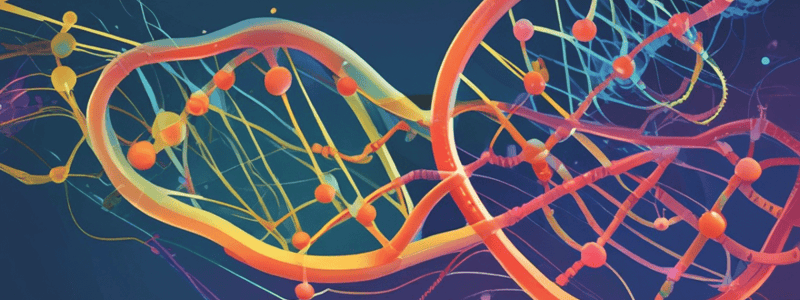Podcast
Questions and Answers
What is the site of translation in a cell?
What is the site of translation in a cell?
- Ribosomes (correct)
- Golgi apparatus
- Mitochondria
- Nucleus
What is the role of RNA polymerases?
What is the role of RNA polymerases?
- To translate mRNA into amino acids
- To transcribe DNA into RNA (correct)
- To synthesize proteins
- To replicate DNA
What is the function of a codon?
What is the function of a codon?
- To transcribe RNA into DNA
- To bind to tRNA
- To determine the position of amino acids during protein synthesis (correct)
- To replicate DNA
What is the process of translating the genetic information from mRNA into a specific sequence of amino acids?
What is the process of translating the genetic information from mRNA into a specific sequence of amino acids?
What is the function of an anticodon?
What is the function of an anticodon?
What are the two main steps of gene expression?
What are the two main steps of gene expression?
What is the shape of a DNA molecule?
What is the shape of a DNA molecule?
Which of the following base pairs have a triple bond?
Which of the following base pairs have a triple bond?
What is the function of RNA polymerase?
What is the function of RNA polymerase?
Which type of RNA carries amino acids to the ribosomes for protein assembly?
Which type of RNA carries amino acids to the ribosomes for protein assembly?
What is the function of messenger RNA (mRNA)?
What is the function of messenger RNA (mRNA)?
Which of the following is NOT a main class of RNA molecules?
Which of the following is NOT a main class of RNA molecules?
What is the function of ribosomal RNA (rRNA)?
What is the function of ribosomal RNA (rRNA)?
What is the process by which a section of DNA is copied into a piece of single-stranded nucleic acid?
What is the process by which a section of DNA is copied into a piece of single-stranded nucleic acid?
What is the primary function of nucleic acids in cells?
What is the primary function of nucleic acids in cells?
What is the type of bond that links nucleotides together in DNA and RNA?
What is the type of bond that links nucleotides together in DNA and RNA?
What is the difference between the sugar molecule in DNA and RNA?
What is the difference between the sugar molecule in DNA and RNA?
What is the nitrogenous base that is found in RNA but not in DNA?
What is the nitrogenous base that is found in RNA but not in DNA?
What is the structure of DNA?
What is the structure of DNA?
What is the term for the repeating unit of DNA and RNA?
What is the term for the repeating unit of DNA and RNA?
What is the type of bonding that holds the two strands of DNA together?
What is the type of bonding that holds the two strands of DNA together?
What is the class of nucleic acids that comes in different molecular forms and plays multiple cellular roles?
What is the class of nucleic acids that comes in different molecular forms and plays multiple cellular roles?
Flashcards are hidden until you start studying
Study Notes
Nucleic Acids
- Nucleic acids are large biomolecules that play essential roles in all cells and viruses, storing and expressing genomic information that determines inherited characteristics.
- There are two main classes of nucleic acids: Deoxyribonucleic acid (DNA) and Ribonucleic acid (RNA).
Structure of Nucleotides
- Nucleotides are the building blocks of DNA and RNA, consisting of:
- Nitrogenous base (purines: adenine and guanine; pyrimidines: cytosine, thymine, and uracil)
- Pentose sugar (deoxyribose in DNA and ribose in RNA)
- Phosphate group
DNA Structure
- DNA is composed of a phosphate-deoxyribose sugar backbone and the nitrogenous bases adenine (A), guanine (G), cytosine (C), and thymine (T).
- DNA forms a double helix with two strands twisted around each other, held together by hydrogen bonding between complimentary base pairs (A-T and G-C).
RNA Structure
- RNA is a single-stranded nucleic acid polymer of the four nucleotides A, C, G, and U, with a backbone of alternating phosphate and ribose sugar residues.
- RNA is made by copying the base sequence of a section of double-stranded DNA, called a gene, into a piece of single-stranded nucleic acid through transcription.
Types of RNA Molecules
- There are three main classes of RNA molecules:
- Messenger RNA (mRNA): copies DNA's instructions and carries them to ribosomes for protein assembly.
- Transfer RNA (tRNA): carries amino acids in the cytoplasm to ribosomes for protein assembly.
- Ribosomal RNA (rRNA): makes up the large and small subunits of ribosomes.
- Other classes of RNA molecules include:
- Small nuclear RNA (snRNA)
- Micro RNA (miRNA)
- Small interfering RNA (siRNA)
- Heterogeneous nuclear RNA (hnRNA)
Gene Expression
- Gene expression is the process by which genetic information stored in a gene is used to synthesize a functional protein.
- Proteins synthesis occurs in two steps:
- Transcription: DNA → RNA
- Translation: RNA → protein
Transcription and Translation
- Transcription is the process of copying a gene's DNA sequence to make an RNA molecule, performed by enzymes called RNA polymerases.
- Translation is the process of translating the transcript (genetic information) from mRNA into a specific sequence of amino acids in the growing chain of a polypeptide.
- The three general steps of translation are:
- Initiation
- Elongation
- Termination
Studying That Suits You
Use AI to generate personalized quizzes and flashcards to suit your learning preferences.

![Molecular Biology: Nucleic Acids Structure [BIO 206]](https://images.unsplash.com/photo-1575468130766-fce03f7afaab?crop=entropy&cs=srgb&fm=jpg&ixid=M3w0MjA4MDF8MHwxfHNlYXJjaHwxMnx8TW9sZWN1bGFyJTIwQmlvbG9neSUyMENlbGwlMjBCaW9sb2d5JTIwTnVjbGVpYyUyMEFjaWRzJTIwQmlvc2NpZW5jZXN8ZW58MXwwfHx8MTcwMzkyNTEyNHww&ixlib=rb-4.0.3&q=85&w=300&fit=crop&h=200&q=75&fm=webp)


